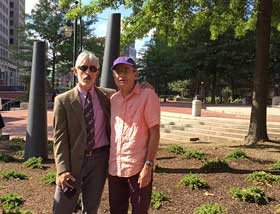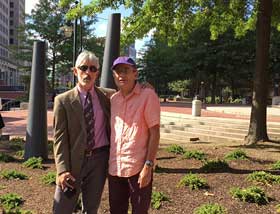 KINGSTON, R.I. – September 10, 2015 – Will Green said the 12 years he worked with survivors of the Holocaust to create the newly installed Rhode Island Holocaust Memorial in Providence was both a labor of love and an urgent race with time.
KINGSTON, R.I. – September 10, 2015 – Will Green said the 12 years he worked with survivors of the Holocaust to create the newly installed Rhode Island Holocaust Memorial in Providence was both a labor of love and an urgent race with time.
The University of Rhode Island landscape architecture professor from West Kingston said his role in the project was to help Rhode Island Holocaust survivors develop a vision and then navigate a path that led to the installation of the memorial. It involved mediating, listening, designing, advocating and whatever else was necessary to move the project forward.
“I became involved because this group of survivors had a real need to tell their story while also celebrating the lives of the victims with Rhode Island connections,” said Green, the coordinating landscape architect for the project. “They wanted to share their memories, and – through the design – influence the next generation.
“The survivors needed someone who cared deeply about the Holocaust and who understood how to get things done,” he added. “My job was to conceptualize the process and bring the pieces together by finding others to help. The survivors had a site and an organization, but they didn’t have a lot of time because of their ages.”
Originally planned for inclusion in the Rhode Island Holocaust Museum, the memorial site next to the Providence River was promised to the group by then-Mayor Vincent Cianci.
While working with the survivors, Green engaged Pawtucket-based sculptor Jonathan Bonner, who teaches at the Rhode Island School of Design, to design the memorial. Green, Bonner and a committee of volunteers spent several years adapting first one design and then another to meet the city’s requirements while funds were being raised for its installation.
The striking memorial was dedicated Aug. 26. It includes a curving granite walkway carved with the image of railroad tracks as a reminder of the way the Holocaust victims arrived at the concentration camps; six black granite columns of different heights to symbolize the six million people who died at all different stages of their lives; and an egg-shaped rock representing hope and signifying the symbolic stone that Jews leave at places of remembrance.
In addition to his role as liaison to all the interested parties, Green put his landscape architecture expertise to work to help address site-specific issues like grading, storm water management, underground utilities, and the placement and survival of plants.
“Without Will’s steadfast commitment to the project, it would never have been completed,” said Bonner, who has created many other large-scale, site-specific public artworks installed around the country.
Green initially became involved in the project at the behest of Len Newman, son of the late David Newman, who was an early advocate for the project and who Green said worked as hard as anyone to get the memorial approved and built.
“It was a wonderful process whereby I became part of this group of people – which included David Brand and Helene and Marty Weismann – who shared their memories and feelings and allowed a team of us to design, massage and coax a memorial into existence,” Green said.
“Between the politics of North Africa and the Middle East and the language that’s entering our political arena in the United States today, it appears that we haven’t learned much from what has come before us. So memorials like this are important to remind and teach people about the past. They bring people together to say this shouldn’t happen again, that it never should have happened,” he added. “That’s why I got involved.”
Pictured above: URI Professor Will Green (left) and sculptor Jonathan Bonner pose at the Rhode Island Holocaust Memorial in Providence. (Photo courtesy of Will Green.)

